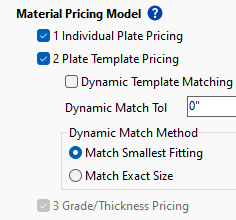Primecut can store cost and sell rates for material, and the granularity with which this is stored is adjustable:
|
A combination of these methods can be used, Primecut will start at the top of this list, the individual plate, and if it is checked AND the plate has a non-zero cost price, it will be used. If the plate's cost 0, it will fall back to the next level, the template for the plate (if the plate was created from a template), if this is 0 it will attempt to get its value from the Grade and Thickness. Similar logic is applied (separately) for the sell price.
Pro Easiest to maintain; always consistent with part-based quoting
Con No differential pricing on different plate sizes or suppliers
In Primecut release 131 and earlier this was the only material pricing model. Each thickness of each grade stores cost and sell rates ($/unit mass). With this model there is no way to distinguish that very large sheets may have different pricing to very small sheets, or that plates from different suppliers may have different prices.
When doing part based quoting, Grade/Thickness prices are always used, as there is no way of knowing which plate size the parts will eventually be nested onto.
Grade Thickness pricing is always available, and if the other options are active (checked) is the fallback value for sellperkg if the plate has 0.00 sellPerKG AND either there is no matching template OR the matching template has 0.00 sellPerKg. (Same occurs for CostPerKg)
Grade Thickness pricing is maintained in Process Data, see Material Thicknesses.
This pricing model is always enabled.
Pro More Flexible pricing, auto fallback to Grade Thickness pricing if data not set
Con More data to maintain, Some ambiguity as to where price came from (template or grade thickness?), different material pricing between Part based and Nest-based quotes. Templates should be created for ALL sizes of plate.
If this mode is activated (by checking the box above), Primecut will attempt to use plate template pricing for nested quotes. This allows different pricing to be applied to:
•Plates of differing size (length and/or width different)
•Plates from a different supplier
To support this, plates should be created from templates, and plates created from templates will remember which template they were created from. When a remnant plate is created, it will inherit its parent plate's template reference, so will inherit its template pricing also.
If the Template's cost/mass is $0.00 (or negative), then the costing system will fall back to the Grade/Thickness cost/mass. The same goes for Sell/Mass.
Plate Template Pricing is maintained when Editing Plate Templates, but the user must have costing data permissions to modify these prices.
Pro Most Flexible pricing
Con Hardest to maintain, Most complex, different material pricing between Part based and Nest-based quotes
Pricing can be applied to each and every plate (if not then the system falls back to Template pricing if available, if not available then material/thickness pricing)
Pricing is maintained via Plate Properties in Nesting Mode. Bulk updates can also be performed by advanced users via SQL queries (tblPlate.CostPerKg, tblPlate.SellPerKG)
Sometimes when quoting custom plates may be created, or created as copies of stock plates with no template reference. If this is checked, Primecut will attempt to match a plate to a plate template using the following rules:
•Material and thickness MUST match
•If the template supplier and plate supplier are both set they must match, if either is not set its a possible match
•Plate must fit within template length and width dimensions (will select the smallest template that fits the plate if multiple found).
A tolerance may be specified, so if a plate is just slightly bigger than a nominal template size, it may still be matched. (This is to prevent problems seen by a customer where sock plate and template sizes differed by a few mm, and as a result some matched plates unexpectedly jumped up to a much bigger and much more expensive template [#18657])
The default matching method is Match Smallest Fitting, which will look for the smallest plate template with length and width dimensions greater than or equal to the plate length and width within Dynamic Match Tol above.
Match Exact Size will only match if the plate length is equal to the template length, and the plate width is equal to the template width, within Dynamic Match Tol above.
